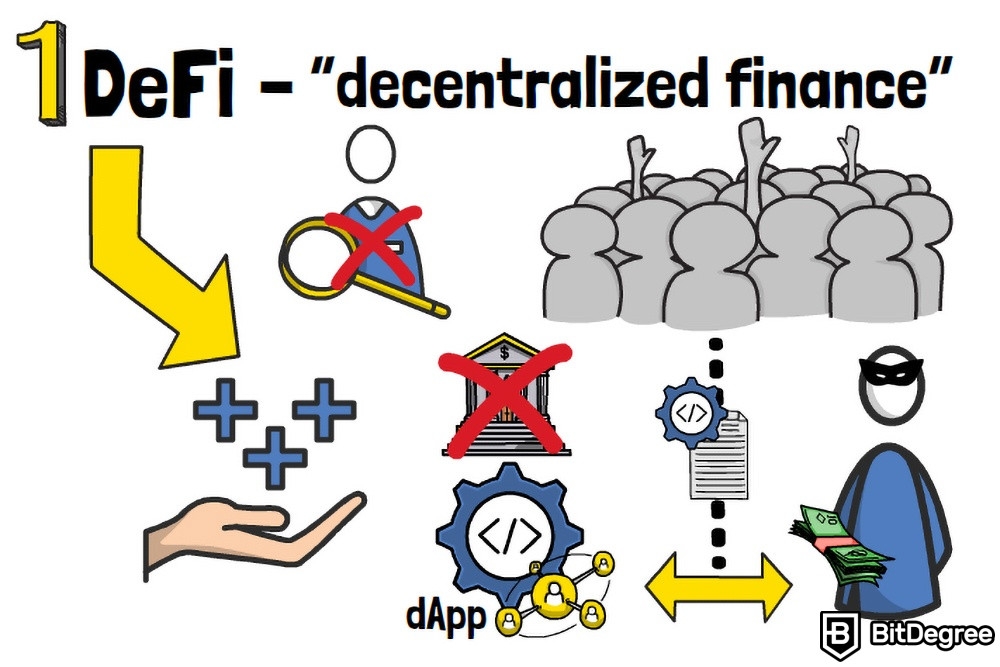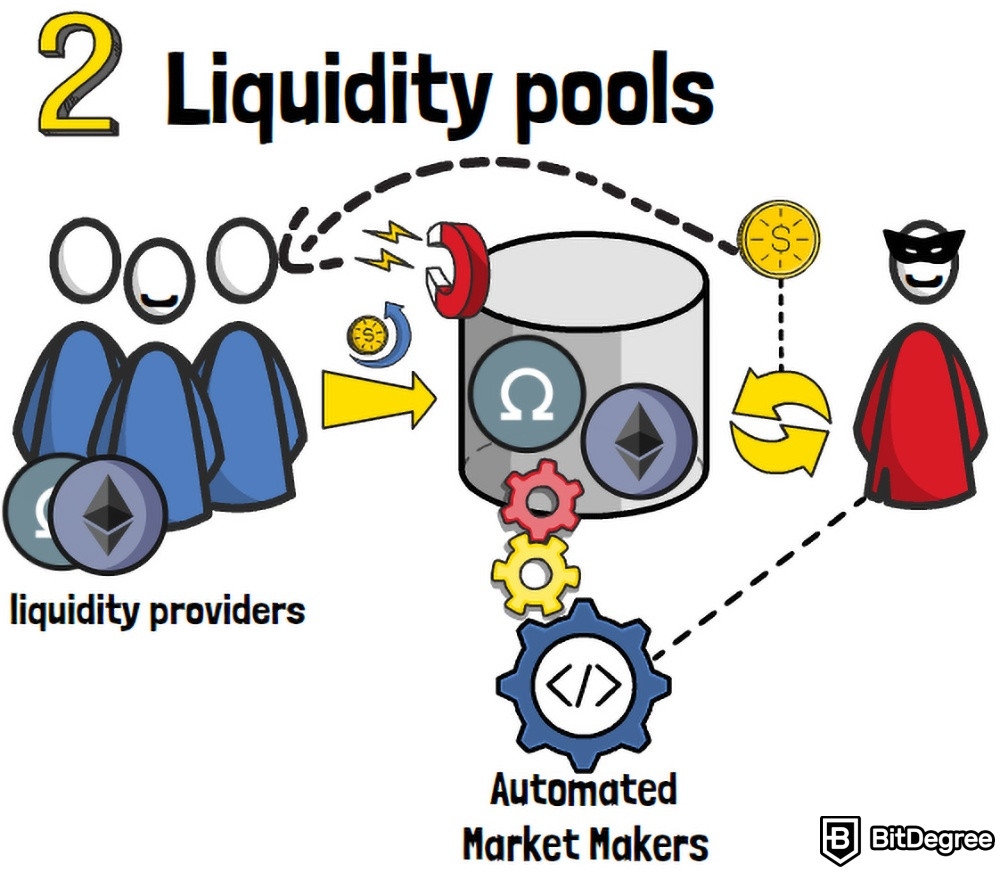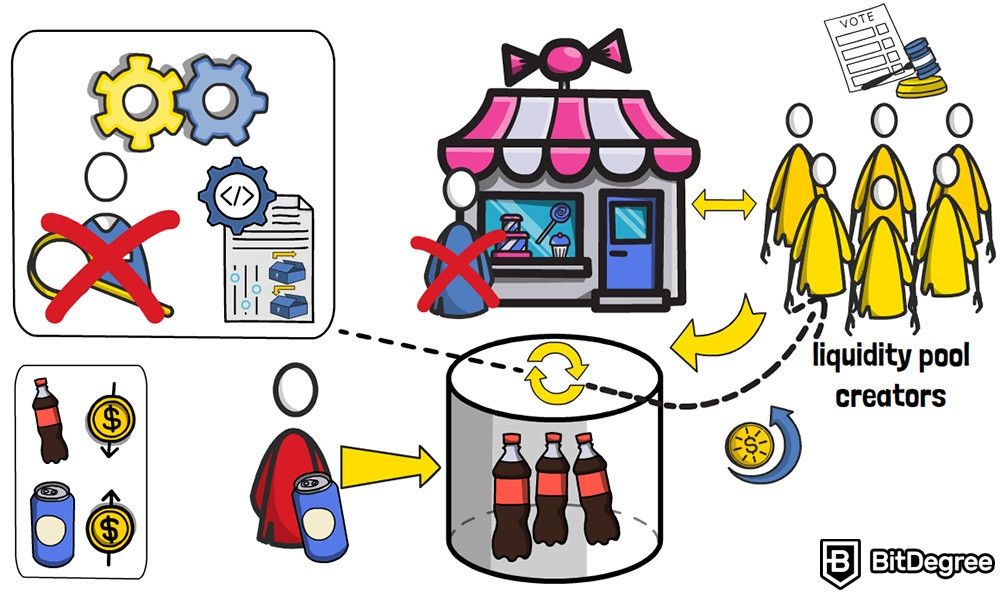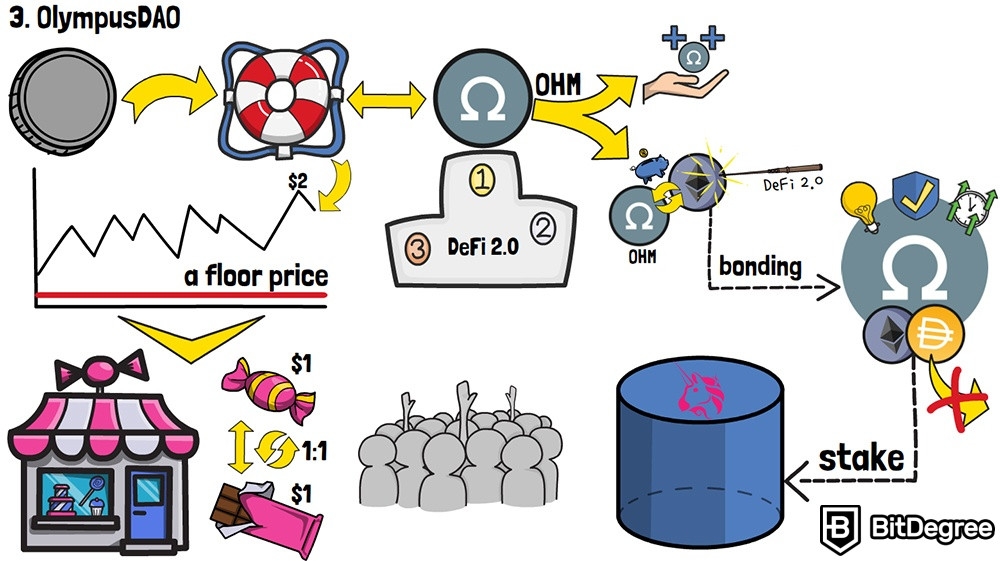cryptocurrency wallet</strong></a>, as well as some funds within it.</span></p>\n<h2>The Main Types of dApps</h2>\n<p>Now, we’ve established that <strong>dApps are applications that are based on blockchains, and that allow people to use them anonymously, securely, and without fear of data aggregation.</strong></p>\n<p>In order for you to get a better understanding of the topic, though, let’s take a look at some of the most popular examples of the different types of dApps that are out there.</p>\n<p>First up, <strong>gaming dApps.</strong> Without a doubt, these are some of the most popular decentralized applications that have come out of the industry. If you’ve heard about <strong>NFT gaming</strong> or “<a href=https://www.bitdegree.org/"/crypto/learn/crypto-terms/what-is-play-to-earn-play2earn/">Play-2-Earn” games, most all of them can be considered dApps.</p>\n<p>Think about <strong>Axie Infinity,</strong> one of the most popular cryptocurrency games on the market. Within the game, you breed and grow creatures called Axies, battle other players, and are able to sell your Axie pets for real-world profits. With all of the amazing features of the game, it’s also decentralized, and built on a blockchain.</p>\n<p><img style=\"display: block; margin-left: auto; margin-right: auto;\" title=\"\" src=https://www.bitdegree.org/"https://assets.bitdegree.org/crypto/storage/media/what-are-dapps-4.o.jpg/" alt=\"What are dApps in crypto: Gaming dApps.\" width=\"800\" height=\"425\" /></p>\n<p>What this means is that you can inspect the code behind the game, check all of its transactions, and play anonymously - no formal registrations, no “self-doxing” (or, revealing sensitive information about yourself), none of that!</p>\n<p>Next up, <strong><a href=https://www.bitdegree.org/"/crypto/learn/crypto-terms/what-is-decentralized-exchange-dex/">decentralized cryptocurrency exchanges</a>.</strong></p>\n<p>A crypto exchange platform is a place where people go to exchange different crypto assets. By default, these platforms are centralized and follow the “<a href=https://www.bitdegree.org/"/crypto/learn/crypto-terms/what-is-know-your-customer-kyc/">Know Your Customer</strong></a>” financial guidelines - in other words, if you want to trade cryptocurrencies on them, you will need to provide your personal information, ID, residential address, and so on.</p>\n<p>Think of the process as you would do with a bank. In order to open a bank account, all of these procedures need to be passed, as well. However, with a bank, you can be sure that you’re providing information to a reliable, established business.</p>\n<p>With cryptocurrency exchanges, though, things aren’t always that simple. Many exchanges, to this day, aren’t really well-established, and you might not even be aware of who you’re dealing with.</p>\n<p>On top of that, <strong>crypto exchanges do still get hacked,</strong> on a rather frequent basis. You risk not only losing your cryptocurrencies but also getting your personal information leaked, as well!</p>\n<p>Now, with a decentralized cryptocurrency exchange (also known as a DEX), most of those concerns are nullified. You won’t need to reveal your personal information, DEXes usually don’t hold your crypto assets, and you are able to trade some niche crypto assets on them, as well!</p>\n<p>The last example that I want to give you while talking about what are dApps is that of the <strong><a href=https://www.bitdegree.org/"/crypto/learn/crypto-terms/what-is-metaverse/">metaverse./nNow, if you’ve spent any time online in the past half a year or so, you might have heard the big news - Mark Zuckerberg, the CEO of Facebook, has announced that his company will now be called Meta and that they will invest in creating metaverse-based technology.</p>\n<p>This is a HUGE topic, so I would highly suggest you’d go and check the section <strong>\"<a href=https://www.bitdegree.org/"/crypto/learn/what-is-the-metaverse/">What is the Metaverse?</a>\". </strong>In short, though, Mark isn’t the first guy to come up with the concept - a “metaverse” is actually just a <strong>digital world</strong> where you can have your own avatar, and interact with other people!</p>\n<p>Where do dApps come in, you might ask? Well, when you’re baking a cake, a cake tin is absolutely necessary - if you try to make a cake without one, it will probably turn out a blob - formless, squished, and unappealing.</p>\n<p><img style=\"display: block; margin-left: auto; margin-right: auto;\" title=\"\" src=https://www.bitdegree.org/"https://assets.bitdegree.org/crypto/storage/media/what-are-dapps-5.o.jpg/" alt=\"What are dApps in crypto: Mark Zuckerberg investing in metaverse-based technology.\" width=\"800\" height=\"350\" /></p>\n<p>The same logic applies to the metaverse, as well! If the underlying technology is poorly-made, the concept itself will be a fluke, too. On the flip side, if the metaverse was built on a decentralized application, this would give it a huge leap in the right direction.</p>\n<p><em>How so? </em>Well, users would be able to remain <strong>anonymous, </strong>all of their transactions and interactions would be <strong>recorded on the blockchain,</strong> and everything happening within the metaverse would be <strong>provably fair.</strong> In other words, everything related to the digital world would be following the rules of the smart contract lying underneath!</p>\n<p>Now, I really don’t want to get any techier than I already have, so I’ll stop with the dApp examples here. That being said, my point through all of this was that dApps have <strong>infinite potential</strong> - there are countless examples and possibilities of how they can be integrated into our lives!</p>\n<h2>dApps in the Future</h2>\n<p>With time, everything is slowly advancing and getting more intricate - it’s certain that decentralized applications will only improve in the future, too! Which dApps could we see sticking around, though - which of them have the best potential?</p>\n<p><img style=\"display: block; margin-left: auto; margin-right: auto;\" title=\"\" src=https://www.bitdegree.org/"https://assets.bitdegree.org/crypto/storage/media/what-are-dapps-6.o.jpg/" alt=\"What are dApps in crypto: dApps in the future.\" width=\"800\" height=\"251\" /></p>\n<p>Well, people probably asked these questions in the early 2000s, when tech stocks were dominating the financial landscape - no one knew which companies would survive and go on to become multi-billion dollar businesses, and which ones would fail!</p>\n<p>When it comes to dApps, <strong>decentralized exchanges</strong> <strong>and projects such as the metaverse</strong> are surely going to stick around in people's minds, at least for some time - projects like these serve some awesome purposes and can be useful in advancing the technology sector, as a whole.</p>","meta_title":"What are dApps in Crypto? The Most Popular Types","meta_description":"Have you ever wondered what are dApps in crypto? If you have, you'll definitely find everything you need to know about dApps right here!","meta_keywords":"what are dapps in crypto, dapps meaning","order":3,"language":"en","created_at":"2022-05-03T11:29:19.000000Z","updated_at":"2023-05-16T11:22:46.000000Z","modified_content":"<p>In this section, I will tell you <strong>all about dApps!</strong></p>\n<p>You probably have different applications installed on your computer - things like a calendar, Facebook, a weather app, some games, and so on.</p>\n<p>Just like you have all of these apps on your computer or phone, there are also dApps - or <a href=https://www.bitdegree.org/"/crypto/learn/crypto-terms/what-are-decentralized-applications-dapps/">decentralized applications</strong></a> -, as well. However, there is one big difference between dApps and your common apps. Be patient though, I'll talk about that in a sec.</p>\n<p>Now, in this section, I’ll cover what dApps are, in the first place, talk about the most common dApp types, and also ponder on how these pieces of software could affect your life, in the future.</p>\n<p><em>Let’s get to it!</em></p>\n<div class=\"container\">\n <div class=\"row justify-content-center\">\n <div class=\"col-md-10 comparison-suggestion pb-3 mb-4\">\n <div class=\"d-flex flex-row\">\n <div class=\"text-center\">\n <div class=\"img-block-yt\">\n <img src=https://www.bitdegree.org/"https://assets.bitdegree.org/crypto/assets/images/compare-crypto-exchanges.gif/"/n alt=\"What are dApps in Crypto? (Explained with Animations)\"\n title=\"What are dApps in Crypto? (Explained with Animations)\" class=\"border-0\">\n <p>Video Explainer</p>\n </div>\n </div>\n <div class=\"col-xs-10 col-sm-10 col-md-10 text-left py-3 yt-info\">\n <h4 class=\"mb-1\">Video Explainer: What Are dApps and How Do They Work?</h4>\n <p class=\"py-1 mb-0 youtube-video-subtitle\">Reading is not your thing? Watch the \"What Are dApps and How Do They Work?\" video explainer</p>\n </div>\n </div>\n <div class=\"row justify-content-center text-center\">\n <div class=\"col-12 col-md-11 px-3\">\n <div class=\"wrapper mb-0\">\n <div class=\"youtube mb-4 bg-transparent p-0 video-modal-popup\" data-toggle=\"modal\"\n data-target=\"#video-modal\" data-id=\"LVASq8IVYA8\" data-title=\"CryptoFinallyExplained\">\n <div class=\"video-gradient-top\"></div>\n <p class=\"text-left dyk-video-title\">What are dApps in Crypto? (Explained with Animations)</p>\n <img src=https://www.bitdegree.org/"https://i.ytimg.com/vi/LVASq8IVYA8/hq720.jpg/"/n alt=\"What are dApps in Crypto? (Explained with Animations)\"\n title=\"What are dApps in Crypto? (Explained with Animations)\"\n class=\"p-0\">\n <img class=\"play-button\" data-target=\"#video-modal\"\n src=https://www.bitdegree.org/"https://assets.bitdegree.org/crypto/assets/video-button.png/"/n alt=\"What are dApps in Crypto? (Explained with Animations)\">\n </div>\n </div>\n </div>\n </div>\n <div class=\"row justify-content-center text-center\">\n <div>\n <a href=https://www.bitdegree.org/"https://www.youtube.com/c/CryptoFinallyExplained?sub_confirmation=1\%22\n class=\"btn yt-promo mb-2\" target=\"_blank\" rel=\"nofollow noopener\">\n <div class=\"row justify-content-center align-items-center mx-0 text-center\">\n <div class=\"col-4 col-md-4\">\n <i class=\"fab fa-youtube yt-dyk-btn\"></i>\n </div>\n <div class=\"col-8 col-md-8 text-center yt-promo-text\">\n <h4 class=\"m-0 text-white\">SUBSCRIBE</h4>\n <span>ON YOUTUBE</span>\n </div>\n </div>\n </a>\n </div>\n </div>\n </div>\n </div>\n</div>\n<div class=\"modal fade\" id=\"video-modal\" tabindex=\"-1\" role=\"dialog\" aria-labelledby=\"LVASq8IVYA8\">\n <div class=\"modal-dialog modal-dialog-centered modal-lg\" role=\"document\">\n <div class=\"modal-content\">\n <div class=\"modal-body p-0\">\n <button type=\"button\" class=\"video-modal-close close\" data-dismiss=\"modal\" aria-label=\"Close\">\n <i aria-hidden=\"true\" class=\"fas fa-times\"></i>\n </button>\n <div id=\"iframe\"></div>\n </div>\n <a class=\"text-decoration-none\"\n href=https://www.bitdegree.org/"https://www.youtube.com/c/CryptoFinallyExplained?sub_confirmation=1\%22\n rel=\"nofollow noopener\" target=\"_blank\">\n <div class=\"modal-footer p-0 d-block bg-white\">\n <div class=\"row justify-content-center m-0\">\n <div class=\"col-3 col-md-4 col-lg-2 p-0\">\n <img class=\"w-100 h-100\" src=https://www.bitdegree.org/"https://assets.bitdegree.org/crypto/assets/crypto-subscribe.jpg/" alt=\"Subscribe\">\n </div>\n <div class=\"col-9 col-md-8 col-lg-2 px-0 d-flex\">\n <div class=\"modal-subscribe w-100\">\n <p class=\"m-0 mt-1 mr-3\">SUBSCRIBE<br>\n <span class=\"m-0\">ON YOUTUBE</span>\n </p>\n </div>\n </div>\n <div class=\"col-12 col-md-12 col-lg-8 p-0 text-center d-flex justify-content-center align-items-center\">\n <div class=\"modal-subscribe-text\">\n <h4 class=\"m-0\">Understand crypto with ease</h4>\n <span>New explainer videos every week!</span>\n </div>\n </div>\n </div>\n </div>\n </a>\n </div>\n </div>\n</div>\n<h2>What are dApps?</h2>\n<p>So - to begin with, let’s establish what are dApps in crypto.</p>\n<p>As I’ve mentioned at the beginning of this section, a “dApp” stands for decentralized application. To continue with the earlier example, dApps aren’t too different from the apps that you have on your devices - games, news applications, social media platforms, and the like.</p>\n<p><img style=\"display: block; margin-left: auto; margin-right: auto;\" title=\"\" src=https://www.bitdegree.org/"https://assets.bitdegree.org/crypto/storage/media/what-are-dapps-1.o.jpg/" alt=\"What are dApps in crypto: Decentralized application.\" width=\"800\" height=\"450\" /></p>\n<p>The key difference, however, lies in the <strong>underlying platform that hosts the app.</strong> So, if you’re using, say, TikTok, all of your information is sent back to the servers of the company - in other words, your data is collected and stored by a centralized institution.</p>\n<p>With dApps, however, this is not the case. Instead, decentralized applications <strong>don’t have a single, governing authority</strong> - <em>it’s in the name, really!</em> All dApps are built not on company-specific servers, but on <a href=https://www.bitdegree.org/"/crypto/learn/crypto-terms/what-is-public-blockchain/">public blockchains</strong></a>.</p>\n<p>Now, a blockchain is a special database that’s used to store information. The things that make it special are that it’s <strong>decentralized</strong> (belonging to no single authority), and that it <strong>stores information in chronological order.</strong> I won’t go further in-depth with the topic, but for the sake of this section, I’ll also mention that <strong>everyone is able to view the transactions</strong> (sales, trades, exchanges, and so on) happening on public blockchains.</p>\n<p>If you’d like to understand how blockchains work in a more thorough manner, check out the <a href=https://www.bitdegree.org/"/crypto/learn/what-is-blockchain/">section dedicated to this topic</strong></a>.</p>\n<p>So - decentralized applications are built on blockchains. <em>What’s the big deal?</em></p>\n<p>Well, the “big deal” here is that, when you’re using a dApp, your <strong>data won’t be siphoned and sent to a centralized institution,</strong> so that they could then sell it to third-party advertisers. On top of that, dApps are governed differently, too - instead of a company making decisions, you have the community behind the dApp responsible for its well-being.</p>\n<p>Such communities are referred to as DAOs. Since it’s a bit of a complex topic, I won’t be discussing it here - make sure to check the <a href=https://www.bitdegree.org/"/crypto/learn/what-is-a-dao-in-crypto/">section about this topic</strong></a> to get a thorough understanding of the whole picture! Suffice to say that, with dApps, the whole community is incentivized to take care of the applications.</p>\n<p>The easiest way to understand everything we’ve talked about up until this point is this: imagine that there are two online social media platforms, like Facebook. Say, the first one is just like the one we have now - the “traditional” Facebook, owned by Meta.</p>\n<p>Now, let’s call the other platform “Decentralized Facebook”. That’s because, while it looks and interacts completely the same as Facebook, it does not belong to Mark Zuckerberg’s company - instead, it’s built on the blockchain and is completely decentralized.</p>\n<p><img style=\"display: block; margin-left: auto; margin-right: auto;\" title=\"\" src=https://www.bitdegree.org/"https://assets.bitdegree.org/crypto/storage/media/what-are-dapps-2.o.jpg/" alt=\"What are dApps in crypto: Traditional Facebook VS Decentralized Facebook.\" width=\"800\" height=\"276\" /></p>\n<p>With traditional Facebook, your personal information is being collected on a regular basis. This information is then sold to advertisers so that they could target those pesky ads at you better. Your personal privacy is invaded, and sold off, for the sake of ad money.</p>\n<p>Decentralized Facebook, on the other hand, acts nothing like that. It only sees the information that you choose to provide, and if you’d like, you are able to remain anonymous on the dApp. No targeted ads, no information gathering.</p>\n<p><img style=\"display: block; margin-left: auto; margin-right: auto;\" title=\"\" src=https://www.bitdegree.org/"https://assets.bitdegree.org/crypto/storage/media/what-are-dapps-3.o.jpg/" alt=\"What are dApps in crypto: Two versions of Facebook.\" width=\"801\" height=\"465\" /></p>\n<p>On top of that, with our current Facebook, Meta (the company behind the platform) makes all of the decisions on what to change, improve, or update. They aren’t too concerned with what the community wants, or what’s best for the social fabric - instead, they only care about their bottom line, even if the cost is less convenient for the user.</p>\n<p>On the flip side, a dApp version of Facebook would be looked over by the community behind it. And who knows what the platform needs better than the actual people who actively use it, every single day?!</p>\n<p>All dApps are run with the help of <strong><a href=https://www.bitdegree.org/"/crypto/learn/crypto-terms/what-is-smart-contract/">smart contracts</a>. </strong>These are automated agreements that are programmed and set on the blockchain - generally speaking, once a smart contract is engaged, it cannot be stopped, changed, or altered. If you’d like to learn more about smart contracts, make sure to check out the section<strong> \"<a href=https://www.bitdegree.org/"/crypto/learn/what-are-smart-contracts/">What are Smart Contracts</a>?\".</strong></p>\n<p><span style=\"font-family: -apple-system, BlinkMacSystemFont, 'Segoe UI', Roboto, Oxygen, Ubuntu, Cantarell, 'Open Sans', 'Helvetica Neue', sans-serif;\">Lastly, as a quick note, in order to start using dApps for yourself, in most cases, you will need to have a <a href=https://www.bitdegree.org/"https://www.bitdegree.org/crypto/best-cryptocurrency-wallet/">cryptocurrency wallet</strong></a>, as well as some funds within it.</span></p>\n<h2>The Main Types of dApps</h2>\n<p>Now, we’ve established that <strong>dApps are applications that are based on blockchains, and that allow people to use them anonymously, securely, and without fear of data aggregation.</strong></p>\n<p>In order for you to get a better understanding of the topic, though, let’s take a look at some of the most popular examples of the different types of dApps that are out there.</p>\n<p>First up, <strong>gaming dApps.</strong> Without a doubt, these are some of the most popular decentralized applications that have come out of the industry. If you’ve heard about <strong>NFT gaming</strong> or “<a href=https://www.bitdegree.org/"/crypto/learn/crypto-terms/what-is-play-to-earn-play2earn/">Play-2-Earn” games, most all of them can be considered dApps.</p>\n<p>Think about <strong>Axie Infinity,</strong> one of the most popular cryptocurrency games on the market. Within the game, you breed and grow creatures called Axies, battle other players, and are able to sell your Axie pets for real-world profits. With all of the amazing features of the game, it’s also decentralized, and built on a blockchain.</p>\n<p><img style=\"display: block; margin-left: auto; margin-right: auto;\" title=\"\" src=https://www.bitdegree.org/"https://assets.bitdegree.org/crypto/storage/media/what-are-dapps-4.o.jpg/" alt=\"What are dApps in crypto: Gaming dApps.\" width=\"800\" height=\"425\" /></p>\n<p>What this means is that you can inspect the code behind the game, check all of its transactions, and play anonymously - no formal registrations, no “self-doxing” (or, revealing sensitive information about yourself), none of that!</p>\n<p>Next up, <strong><a href=https://www.bitdegree.org/"/crypto/learn/crypto-terms/what-is-decentralized-exchange-dex/">decentralized cryptocurrency exchanges</a>.</strong></p>\n<p>A crypto exchange platform is a place where people go to exchange different crypto assets. By default, these platforms are centralized and follow the “<a href=https://www.bitdegree.org/"/crypto/learn/crypto-terms/what-is-know-your-customer-kyc/">Know Your Customer</strong></a>” financial guidelines - in other words, if you want to trade cryptocurrencies on them, you will need to provide your personal information, ID, residential address, and so on.</p>\n<p>Think of the process as you would do with a bank. In order to open a bank account, all of these procedures need to be passed, as well. However, with a bank, you can be sure that you’re providing information to a reliable, established business.</p>\n<p>With cryptocurrency exchanges, though, things aren’t always that simple. Many exchanges, to this day, aren’t really well-established, and you might not even be aware of who you’re dealing with.</p>\n<p>On top of that, <strong>crypto exchanges do still get hacked,</strong> on a rather frequent basis. You risk not only losing your cryptocurrencies but also getting your personal information leaked, as well!</p>\n<p>Now, with a decentralized cryptocurrency exchange (also known as a DEX), most of those concerns are nullified. You won’t need to reveal your personal information, DEXes usually don’t hold your crypto assets, and you are able to trade some niche crypto assets on them, as well!</p>\n<p>The last example that I want to give you while talking about what are dApps is that of the <strong><a href=https://www.bitdegree.org/"/crypto/learn/crypto-terms/what-is-metaverse/">metaverse.
/nNow, if you’ve spent any time online in the past half a year or so, you might have heard the big news - Mark Zuckerberg, the CEO of Facebook, has announced that his company will now be called Meta and that they will invest in creating metaverse-based technology.</p>\n<p>This is a HUGE topic, so I would highly suggest you’d go and check the section <strong>\"<a href=https://www.bitdegree.org/"/crypto/learn/what-is-the-metaverse/">What is the Metaverse?</a>\". </strong>In short, though, Mark isn’t the first guy to come up with the concept - a “metaverse” is actually just a <strong>digital world</strong> where you can have your own avatar, and interact with other people!</p>\n<p>Where do dApps come in, you might ask? Well, when you’re baking a cake, a cake tin is absolutely necessary - if you try to make a cake without one, it will probably turn out a blob - formless, squished, and unappealing.</p>\n<p><img style=\"display: block; margin-left: auto; margin-right: auto;\" title=\"\" src=https://www.bitdegree.org/"https://assets.bitdegree.org/crypto/storage/media/what-are-dapps-5.o.jpg/" alt=\"What are dApps in crypto: Mark Zuckerberg investing in metaverse-based technology.\" width=\"800\" height=\"350\" /></p>\n<p>The same logic applies to the metaverse, as well! If the underlying technology is poorly-made, the concept itself will be a fluke, too. On the flip side, if the metaverse was built on a decentralized application, this would give it a huge leap in the right direction.</p>\n<p><em>How so? </em>Well, users would be able to remain <strong>anonymous, </strong>all of their transactions and interactions would be <strong>recorded on the blockchain,</strong> and everything happening within the metaverse would be <strong>provably fair.</strong> In other words, everything related to the digital world would be following the rules of the smart contract lying underneath!</p>\n<p>Now, I really don’t want to get any techier than I already have, so I’ll stop with the dApp examples here. That being said, my point through all of this was that dApps have <strong>infinite potential</strong> - there are countless examples and possibilities of how they can be integrated into our lives!</p>\n<h2>dApps in the Future</h2>\n<p>With time, everything is slowly advancing and getting more intricate - it’s certain that decentralized applications will only improve in the future, too! Which dApps could we see sticking around, though - which of them have the best potential?</p>\n<p><img style=\"display: block; margin-left: auto; margin-right: auto;\" title=\"\" src=https://www.bitdegree.org/"https://assets.bitdegree.org/crypto/storage/media/what-are-dapps-6.o.jpg/" alt=\"What are dApps in crypto: dApps in the future.\" width=\"800\" height=\"251\" /></p>\n<p>Well, people probably asked these questions in the early 2000s, when tech stocks were dominating the financial landscape - no one knew which companies would survive and go on to become multi-billion dollar businesses, and which ones would fail!</p>\n<p>When it comes to dApps, <strong>decentralized exchanges</strong> <strong>and projects such as the metaverse</strong> are surely going to stick around in people's minds, at least for some time - projects like these serve some awesome purposes and can be useful in advancing the technology sector, as a whole.</p>","preview_url":"https://www.bitdegree.org/crypto/learn/what-are-dapps-in-crypto","youtube_video":{"id":14,"channel_id":1,"sort":48,"video_title":"What are dApps in Crypto? (Explained with Animations)","description":"What are dApps in crypto?\n\n“dApp” stands for “decentralized application”. It’s a type of app built on a blockchain, and coded with the logic of smart contracts. \n\nPopular types of dApps include decentralized exchanges “DEXs”, blockchain-based “Play-to-Earn” games, NFT marketplaces, and so on. In order to use dApps, all that you will need to have is a cryptocurrency wallet, and some funds within it. In this video, I will break down the concept of dApps in a simple manner, as well as mention some popular examples of well-known decentralized applications.\n\nHave you ever used a dApp before? If so, which one? Do share your experience, in the comment section below!\n\nVideo Time Table:\n\n0:00 Introduction to What are Dapps in Crypto\n0:54 What are dApps in Crypto?\n5:02 Gaming dApps\n5:45 Decentralized Cryptocurrency Exchanges (DEX)\n6:54 dApps in the Metaverse\n8:19 Wrap-up: What are dApps in Crypto?\n\nGet Quick Crypto Tips on Twitter - Follow:\nhttps://twitter.com/crypto_xplained\n\n#WhatAredAppsinCrypto #dAppsMeaning #dApps #WhatisadApp #dAppsinCrypto","video_id":"LVASq8IVYA8","duration":562,"view_count":968,"thumbnail_url":"https://i.ytimg.com/vi/LVASq8IVYA8/hq720.jpg","thumbnail_width":1280,"thumbnail_height":720,"published_at":"2022-03-03 14:52:59","created_at":"2022-03-03T23:00:02.000000Z","updated_at":"2023-05-21T23:00:04.000000Z","channel":{"id":1,"title":"CryptoFinallyExplained","channel_id":"UCOryUY0yxC08eJtK23mNgiA","main_playlist_id":"UUOryUY0yxC08eJtK23mNgiA"}}},"prevSection":{"id":8,"featured_image_id":6482,"original_id":null,"youtube_video_id":5,"author_id":40,"translator_id":null,"chapter_id":6,"title":"What is Decentralized Finance (DeFi)?","slug":"what-is-defi","definition":"Did you know that DeFi makes transactions happen in a matter of seconds?","status":"published","content":"<p>In this section, I’ll explain to you what is DeFi, also known as decentralized finance!</p>\n<p>If you were to take a look at Google Trends DeFi-term-related topics, you’d notice that this crypto sector has literally exploded sometime around October 2020, and YES, it has been climbing up in usage and popularity ever since. Just as there are skeptics, there are also many people who believe that decentralized finance will be the true future of the monetary system we have today, both on a local and a global scale.</p>\n<p>Here, we’ll unravel what DeFi is. Furthermore, we’ll take a look at <strong>how DeFi is different</strong> from all of the traditional financial tools that are common nowadays, and also elaborate on the potential future of the sector, as well.</p>\n<p>Without wasting any time, let’s get right to it!</p>\n<h2>What is DeFi?</h2>\n<p>So, as I mentioned before, the term “DeFi” is an abbreviation of “decentralized finance”. We’ll break it down in a second, but in general, DeFi refers to a new type of financial operations that are considered to be much faster, cheaper, and more user-friendly than those complicated ones we are currently used to.</p>\n<p>The term “decentralized” simply means that there is <strong>no single authority</strong> behind the concept. Instead, it belongs to the masses - the community behind the concept is in-charge of its development, and all decisions are made via a democratic vote, instead of a single CEO, director, or even the secret Illuminati family telling everyone what to do.</p>\n<p style=\"text-align: center;\"><img title=\"What is DeFi: Financial operations.\" src=https://www.bitdegree.org/"https://assets.bitdegree.org/crypto/storage/media/what-is-defi-1.o.jpg/" alt=\"What is DeFi: Financial operations.\" width=\"800\" height=\"454\" /></p>\n<p>Imagine a grocery store. By default, the store would be owned by a single person - the store owner would be in charge of making all of the important decisions, while each of the employees would be responsible for their own duties within the store. If the owner made some bad decisions, and the store would go bankrupt, the employees would become jobless, even though they did nothing wrong.</p>\n<p>In other words, this places a huge responsibility on a single individual, or a couple of people. If the same store was governed via a decentralized model, there would be no single store owner - instead, all of the employees would be responsible for the well-being of the establishment, and would make decisions by <strong>voting on proposals.</strong></p>\n<p>In general, decentralization is a hot topic in crypto, and this is especially true in the field of finance. DeFi offers a new way to view and interact with services such as lending and borrowing, banking, money safekeeping, gambling, and much more. Today, the entire premise of decentralized finance is built on <a href=https://www.bitdegree.org/"/crypto/learn/crypto-terms/what-is-blockchain/">blockchain technology.</p>\n<p>Blockchains are essentially places where data is kept. </p>\n<p>It’s like a folder on your computer, containing a heap of different photos. Instead of the folder, though, you have the <strong>blocks,</strong> and instead of your computer where these folders are stored, we have the blockchain, <strong>a</strong> <strong>distributed network</strong> of those folders. Finally, just imagine that this computer and folders on it can be accessed and viewed by anyone around the world, hassle-free (if the blockchain is public, that is - most of them are).</p>\n<p>The blocks of data are connected with virtual chains - this means that the information is stored chronologically, and each new block references the one before. In other words, if you bought an apple and then a chocolate bar the next day, you won’t be able to prove that the chocolate purchase came first. And yes, it’s wrongly assumed that blockchain data is ultra-private. It’s not! </p>\n<p>To your surprise, on the contrary, all your actions on the public blockchain are visible. Anyone can go to the blockchain explorer and easily check who, when, to whom the funds were sent, and what the value of the transaction was. Even what fees were paid for this transaction are visible.</p>\n<p style=\"text-align: center;\"><img title=\"What is DeFi: DeFi on a blockchain.\" src=https://www.bitdegree.org/"https://assets.bitdegree.org/crypto/storage/media/what-is-defi-2.o.jpg/" alt=\"What is DeFi: DeFi on a blockchain.\" width=\"800\" height=\"652\" /></p>\n<p>Probably, you’ll think: <em>Oh man, it’s so bad!</em> </p>\n<p>But you know what? This is the whole beauty of crypto, and what makes it special! All these types of features are very <strong>essential to DeFi!</strong></p>\n<p>Now, think of it this way: One day you decided to take a loan, let's say, for your dream car! You get yourself to the bank, and start arranging the details with the manager. Everything seems to be going great, up until the point when the manager decides to check your credit score.</p>\n<p>Maybe you’re late on paying back a previous loan? Perhaps you’ve had some other financial issues that you might have solved, yet the credit score doesn’t show that?</p>\n<p>Well, the manager would check your financial history - <strong>the purchases and <a href=https://www.bitdegree.org/"/crypto/learn/crypto-terms/what-is-transaction-tx/">transactions
that you’ve made, any previous loans that you’ve taken out, your debts, and so on. If, say, your credit score is bad, as sad as it is, the manager will deny your loan, and that dream car will have to wait!</p>\n<p>On top of that, the whole entire process will take quite a while to go through - you’d have to wait in queues, dig up all sorts of documents, make a wide array of phone calls, and so on. This is tedious and tiring!</p>\n<p>In decentralized finance, all of these processes can be done instantly, thanks to the earlier-mentioned chronological data storage quality!</p>\n<p style=\"text-align: center;\"><img title=\"What is DeFi: DeFi vs CeFi.\" src=https://www.bitdegree.org/"https://assets.bitdegree.org/crypto/storage/media/what-is-defi-3.o.jpg/" alt=\"What is DeFi: DeFi vs CeFi.\" width=\"800\" height=\"339\" /></p>\n<p>Now, if you’d like to learn what types of data can be stored on blockchains, or are interested in studying blockchain technology a bit further, you can check out the section on <a href=https://www.bitdegree.org/"/crypto/learn/what-is-blockchain/">

















